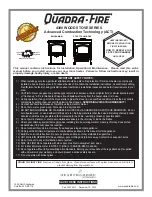
2 Installation instructions
2.1 Warning to the user
All the local and national regulations, and in
particular those relating to national and European
standards, must be observed when installing the
appliance.
An incorrectly installed heating appliance can
cause serious accidents
(chimney fires, burning of
plastic insulation materials, in partition walls, etc...).
The insulation of both the appliance and the
exhaust gas pipe has to be reinforced
and done
a c c o r d i n g t o t h e Sta n d a r d s a n d t h e B u i l d i n g
Regulations for safety reasons. The installation must be
carried out according to the Standards and the Building
Regulations.
Failure to respect the mounting instructions leads to
engage the responsibility of the one doing the
installation.
The manufacturer’s responsibility shall be limited to the
supply of the appliance.
2.2 Location of the unit
Ventilation :
For satisfactory appliance operation with
a
natural draught
, check that sufficient air for
combustion is available in the room. In houses
equipped with one VMC (controlled mechanical
ventilation), this one aspire and renew the ambient air ;
in this case, the residence is under slight low pressure
and a
non-sealable
external air intake must be
installed in addition to the chimney itself, at least 50 cm²
in section.
Position of the unit :
For new installations, select a
central position within the house, to provide a good heat
distribution around the building. The heat distribution
towards the other rooms will be made through the
communicating doors. These rooms must be at low
pressure or fitted with
non-adjustable air registers,
placed so that they cannot be obstructed
, to
encourage circulation of the hot air.
Floor and walls :
Make
s u r e
t h e r e
a r e
n o t
combustible or covered
with combustible material.
O t h e r w i s e
i t
m u s t
necessary to install a
n o n - c o m b u s t i b l e
protection. There must be
a clearance of at least
150 mm at each side of the
appliance and at the back
of the appliance from a
non-combustible wall.
This distance must be
extended to a minimum
clearance of 400 mm from
a n y
c o m b u s t i b l e
m a t e r i a l s .
T h i s
m e a s u r e m e n t m a y b e
reduced to a minimum gap
o f 5 0 m m w h e n t h e
non-combustible wall is at
least 200 mm thick.
There should ideally be a minimum gap of 300 mm at
the right hand side of the stove, this will ensure the best
possible access to the loading door. When using a
single wall flue pipe, there must be a clearance (A) of at
least three times its diameter (B) from any combustible
materials. If the appliance has to be located in an
opening, this distance must be extended to a minimum
clearance (A) of 450 mm from the pipe or the stove body
to any combustible materials.
Hearth :
The appliance must stand on a fireproof
hearth.
It is possible to provide a hearth made of non
combusible board/sheet material or tiles at least 12 mm
thick (C).
Constructional hearths should be constructed of solid
non combustible material at least 125 mm thick
(including the thickness of any non combustible floor
under the hearth).
The hearth must protrude at least 300 mm in front of the
stove and 150 mm each side.
Hearths are provided to prevent combustion appliances
setting fire to the building fabric and furnishings and to
limit the risk of people being accidentally burnt.
Therefore, they should be separated from adjacent
combustible materials and should be satisfactorily
delineated from surrounding floor finishes (carpets
etc...) as follows.
Combustible material should not be placed under a
constructional hearth for a solid fuel appliance within a
vertical distance of 250 mm from the upper surface of
the hearth, unless there is an airspace of at least 50 mm
between the combustible material and the underside of
the hearth.
Where a superimposed hearth has been placed onto a
constructional hearth, combustible material placed on
or besid the constructional hearth should not extend
under the superimposed hearth by more than 25 mm or
closer to the appliance than 150 mm.
E n s u r e t h a t t h e h e a r t h ( s u p e r i m p o s e d o r
constructional) is suitably delineated to discourage
combustible floor finishes from being laid too close to
4
Technical manual “1217”
“ARDENNES” - model 134 13 18
Installation instructions
1 5 0
1 5 0
1 5 0
3 0 0
1 5 0
B
A
A
C
1 5 0
Figure 2 - Minimum clearances
















































